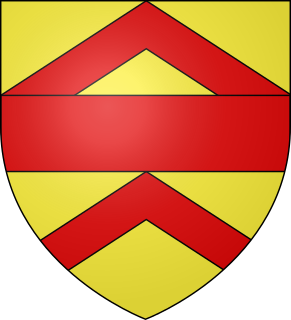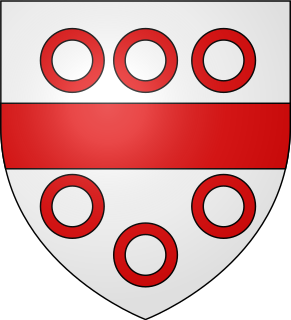History
The title was created on 17 January 1554 for Sir Edward North, a successful lawyer, clerk of the Parliament and chancellor of the Court of Augmentations. The barony was created by writ, which means that it can descend through both male and female lines. Lord North was succeeded by his son Roger, the second Baron. He was English ambassador to France, Treasurer of the Household and Lord-Lieutenant of Cambridgeshire. On his death, the title passed to his grandson Dudley, the third Baron. He was also Lord-Lieutenant of Cambridgeshire. He was succeeded by his son, also named Dudley, the fourth Baron. He represented Horsham and Cambridgeshire in the House of Commons. His second son the Hon. Sir Francis North was created Baron Guilford in 1683.
Lord North was succeeded by his eldest son, the fifth Baron. He married a daughter of the first Baron Grey of Warke and in 1673, four years before he succeeded his father, he was raised to the Peerage of England in his own right as Baron Grey, of Rolleston in the County of Stafford. He was succeeded in both peerages by his son, the sixth Baron. He served as Lord-Lieutenant of Cambridgeshire. He was created a Jacobite peer as 'Earl North' on 6 January 1722. [1] He was childless and on his death in 1734 the Jacobite earldom (such as it was) and the barony of Grey became extinct. He was succeeded in the barony of North by his cousin the third Baron Guilford, who became the seventh Baron North as well. In 1752 he was created Earl of Guilford in the Peerage of Great Britain. The barony of North remained a subsidiary title of the earldom until the death of his grandson, the third Earl, in 1802. He had no sons and was succeeded in the barony of Guilford and earldom by his younger brother (see the Earl of Guilford for later history of these titles). The barony of North, meanwhile, fell into abeyance between his daughters.
The peerage remained in abeyance for thirty-nine years, until the abeyance was terminated in 1841 in favour of the late Earl's second daughter Susan North, who became the tenth holder. She was the wife of John North, a Colonel in the Army and Member of Parliament. Born John Doyle, he had assumed the surname of North in lieu of Doyle in 1838. The title descended in the direct line until the death of her great-great-grandson, the thirteenth Baron (who had succeeded his grandfather), in 1941. Lord North was killed in action as a member of the crew of HMS Neptune . On his death, the barony fell into abeyance between his two sisters, Dorothy Anne Graham (1915–2011) and Susan Silence Beauchamp (1920–1999).

Baron de Ros of Helmsley is the premier baron in the Peerage of England, created in 1288/89 for William de Ros, with precedence to 24 December 1264. Premier baron is a designation and status awarded to the holder of the most ancient extant barony of the Peerage of England. Before the Dissolution of the Monasteries the Prior of the Order of St John in England was deemed premier baron.

Baron Hastings is a title that has been created three times. The first creation was in the Peerage of England in 1290, and is extant. The second creation was in the Peerage of England in 1299, and became extinct on the death of the first holder in c. 1314. The third creation was in the Peerage of England in 1461, and has been in abeyance since 1960.

Baron FitzWalter is an ancient title in the Peerage of England. It was created on 24 June 1295 for Robert FitzWalter. The title was created by writ, which means that it can descend through both male and female lines. His great-grandson, the fourth baron, was an Admiral of the Fleet. The fourth baron's grandson, the sixth baron, died from dysentery at the siege of Harfleur. He was succeeded by his brother, the seventh baron, who was the last known male line descendant of Rollo of Normandy, was succeeded by his daughter and only child, Elizabeth. She was the wife of John Radcliffe. Their son, the ninth baron, was attainted for treason in 1495 with his title forfeited. However, his son Robert Radcliffe obtained a reversal of the attainder by Act of Parliament in 1509 and later served as Lord Lieutenant of Lancashire. He was created Viscount FitzWalter in 1525 and Earl of Sussex in 1529. His grandson, the third earl, was summoned to the House of Lords through a writ of acceleration in 1553 in his father's junior title of Baron FitzWalter. Lord Sussex later served as Lord Deputy of Ireland. He was succeeded by his younger brother, the fourth earl. He had earlier represented Maldon, Hampshire and Portsmouth in the House of Commons and also served as Lord Lieutenant of Hampshire. When he died the titles passed to his only child, the fifth earl. He was Lord Lieutenant of Essex.

Baron Clinton is a title in the Peerage of England. Created in 1298 for Sir John de Clinton, it is the seventh-oldest barony in England.

Baron de Clifford is a title in the Peerage of England. It was created in 1299 for Robert de Clifford (c.1274–1314), feudal baron of Clifford in Herefordshire, feudal baron of Skipton in Yorkshire and feudal baron of Appleby in Westmoreland. The title was created by writ, which means that it can descend through both male and female lines. The Norman family which later took the name de Clifford settled in England after the Norman Conquest of 1066 and was first seated in England at Clifford Castle in Herefordshire. The first Baron served as Earl Marshal of England but was killed at the Battle of Bannockburn in 1314. His 8th generation descendant the 11th Baron, was created Earl of Cumberland in 1525, whose grandson the 3rd Earl was a noted naval commander. On the latter's death in 1605 the earldom passed to his younger brother, the 4th Earl.

Baron Willoughby de Eresby is a title in the Peerage of England. It was created in 1313 for Robert de Willoughby. Since 1983, the title has been held by Jane Heathcote-Drummond-Willoughby, 28th Baroness Willoughby de Eresby.

Earl of Guilford is a title that has been created three times in history. The title was created for the first time in the Peerage of England in 1660 for Elizabeth Boyle. She was a daughter of William Feilding, 1st Earl of Denbigh, and the widow of Lewis Boyle, 1st Viscount Boyle of Kinalmeaky. The title was for life only and became extinct on her death in 1667. The title was created for a second time in the Peerage of England in 1674 for John Maitland, 1st Duke of Lauderdale. For more information on this creation, see the article on him as well as the Earl of Lauderdale.

Baron Berners is a barony created by writ in the Peerage of England.

Baron Lucas is a title that has been created twice in the Peerage of England. The second creation is extant and is currently held with the title Lord Dingwall in the Peerage of Scotland.

Baron Dacre is a title that has been created three times in the Peerage of England, every time by writ.

Baron Dudley is a title in the Peerage of England. It was created circa 1440 for John Sutton, a soldier who served as Lord Lieutenant of Ireland. The title descended in the Sutton family until the 17th century when Frances Sutton, the heir apparent to the title, married Humble Ward, who, himself, was granted the title Baron Ward in 1644. Their heirs inherited both titles until 1740 when the differing rules of inheritance meant that the Barony of Dudley descended on Ferdinando Dudley Lea, who became the 11th Baron whilst the Barony of Ward went to John Ward, who later became 1st Viscount Dudley and Ward. On Ferdinando's death in 1757, the title fell into abeyance. The title was revived in 1916.
Baron Darcy de Knayth is a title in the Peerage of England. It was created in 1332 for John Darcy with remainder to his heirs general, allowing daughters to inherit.

Baron Strange is a title which has been created four times in the Peerage of England. Two creations, one in 1295 and another in 1326, had only one holder each, upon whose deaths they became extinct. Two of the creations, that of 1299 and that of 1628, are extant. The surname Le Strange was Latinized as Extraneus. The arms of Le Strange of Knockin Castle in Shropshire were: Gules, two lions passant argent.

Earl of Plymouth is a title that has been created three times: twice in the Peerage of England and once in the Peerage of the United Kingdom.
Baron Lisle was a title which was created five times in the Peerage of England during the Middle Ages and Tudor period, and once in the Peerage of Ireland in the 18th century.

Baron Howard de Walden is a title in the Peerage of England. It was created by writ of summons in 1597 by Queen Elizabeth I for Admiral Lord Thomas Howard, a younger son of Thomas Howard, 4th Duke of Norfolk, by his second wife, the Honourable Margaret Audley, daughter of Thomas Audley, 1st Baron Audley of Walden.
Baron Fauconberg is an hereditary title created twice in the Peerage of England.

Earl of Stamford was a title in the Peerage of England. It was created in 1628 for Henry Grey, 2nd Baron Grey of Groby. This Grey family descended through Lord John Grey, of Pirgo, Essex, younger son of Thomas Grey, 2nd Marquess of Dorset, and younger brother of Henry Grey, 1st Duke of Suffolk ; Suffolk was executed for treason in 1554 forfeiting his titles.

Baron Wentworth is a title in the Peerage of England. It was created in 1529 for Thomas Wentworth, who was also de jure sixth Baron le Despencer of the 1387 creation. The title was created by writ, which means that it can descend via female lines.
Lord North (1732–1792) was Prime Minister of Great Britain from 1770 to 1782.










